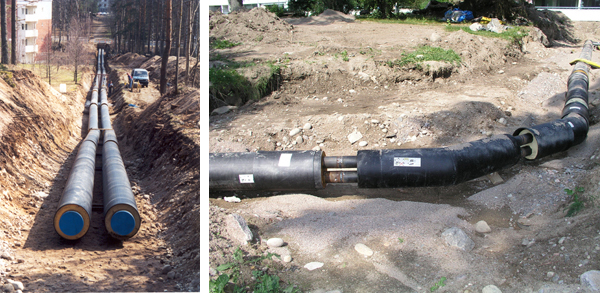District heating networks
Kaukolämpöverkoston pituus Suomessa on noin 16 000 kilometriä. The high reliability of the district heating system is due to quality assurance in construction and systematic maintenance and renovation.
In the district heating networks, the thermal energy produced at the production plants is transmitted to customers as hot water in a closed district heating network consisting of two pipes (supply and return pipes). The district heating water circulating in the supply pipes entering the house releases its heat to customers via heat exchangers, and the return pipe conveys the water back to the production plant for reheating. District heating water does not circulate in the heating networks of buildings. The temperature of district heating water in the supply pipe varies according to the weather between 65 and 115 ºC and in the return pipe usually between 40 and 60 °C.
The district heating water is treated to remove mechanical impurities and oxygen and to prevent corrosion inside the pipes. It is often also coloured to localise any leaks. The colourant that turns the water slightly green is not hazardous to health or the environment.
District heating pipes are laid underground, usually at a depth of 0.5 to 1 metre under streets, pavements, cycleways or parkland, with large pipes sometimes also laid in tunnels. The pipes have effective thermal insulation. Of the energy transmitted by the pipes in Finland, heat losses in the distribution network account for 8–9 per cent.
The total length of the district heating network in Finland at the end of 2021 was about 16 000 km. The flow pipe diameter varies from 20 mm in pipes connecting houses to the network to 1,000 mm in pipes coming out of the Vuosaari power plant. In cities and in other major population centres, the network covers virtually the entire area that can be connected economically to the district heating system. The length of the network increases by 250–500 km each year, mainly as extensions to the existing network and as branch lines to connect new buildings to the system. About 50–70 km of old pipes are refurbished each year.
The current district heating pipes are, as in the enclosed pictures, so-called bonded pipes where the urethane insulation between the steel flow pipe and the plastic protection pipe binds the structure into a single prefabricated entity. The supply and return pipe can be inside the same pipe or in a separate protection pipe. The lifetime of these pipes is long, up to 100 years.

Our expert on this topic

Land use and contract matters, licensing processes for the installation of energy networks and installations, district heating and natural gas distribution and networks, quality assurance of district heating pipes